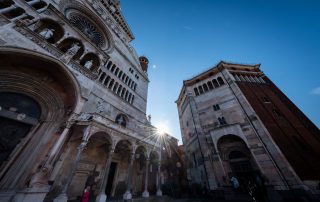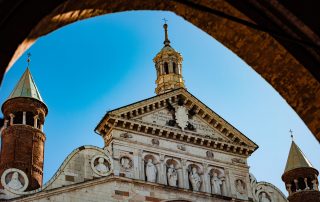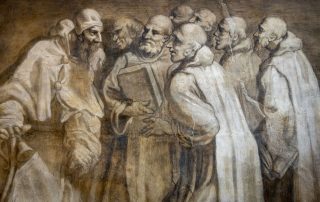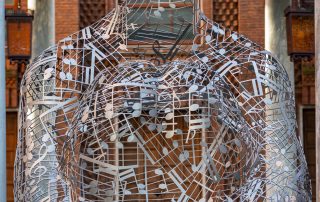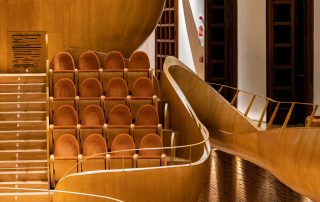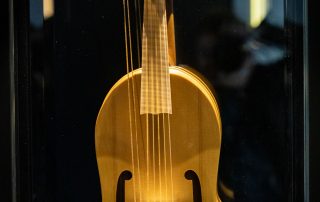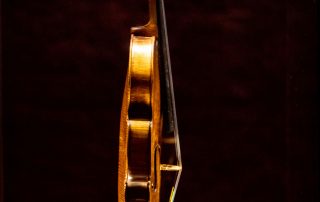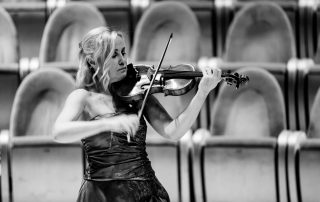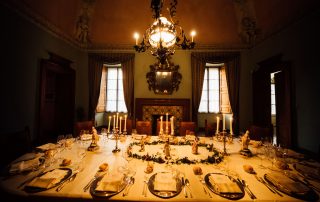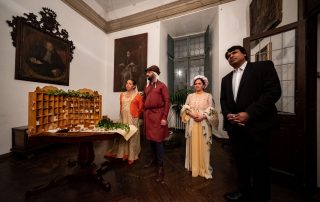PARMA, MANTUA AND CREMONA
THE VERDI FESTIVAL
Embark on an experience for all senses, jump back in time to meet the power and dreams of the Renaissance Lords of
Italy, the musicians and composers that made Italy the country of Opera in the world, enlighten your sight toward the
creations of famous masters and prepare your palate for the most exclusive gourmand destination.
DISCOVER MORE, MAKE YOUR LOGIN


PARMA
In one of Italy’s most prosperous areas, Parma is an incredible city with a powerful history, great artistic and cultural
heritage and enough ham, cheese and Lambrusco to feed the most voracious gourmand person. Parma has been elected
Creative City of Gastronomy and City of Culture from UNESCO.
HISTORY AND ART
Rich in history, art and culture, Parma has been shaped through the centuries by great painters and architects such as Antelami, Parmigianino, Correggio and Leonardo da Vinci.
Suggestive the heritage that people left to the city: the harmony of Correggio, the beauty of Marie Louise of Austria, the talent of Verdi, the genius of Toscanini.
- Visit to the Rocca of Soragna, a 14th century fortress, the historical house of the province of Parma, and welcomed by Prince Dio Febo enjoy a private concert and an exclusive dinner in one of the most suggestive rooms.
- With a private historical guide visit the highlights of the city:
- the palace of the Pilotta, conceived as a place of service of the court,
- the famous Teatro Farnese, one of the most breath-taking sites in all of Parma if not of Italy. Built in 1618 by order of Ranuccio I, duke of Parma and Piacenza, and designed by the ferrarese architect, Giovan Battista Aleotti, the theatre was built to celebrate the passing of Cosimo II de’ Medici.
- the National Gallery with focus on the two great masters active in the sixteenth century in Parma, Correggio, Parmigianino and Leonardo da Vinci.
- the Church of St. John the Evangelist dating back to the tenth century.
- the Cathedral , one of the finest examples of Romanesque with frescoes by Correggio and sculptures by Antelami, and the 13th century’s Baptistery built in pink marble octagonal layout.


VERDI OPERA FESTIVAL
The Verdi Festival, from the 27th of September till the 21st of October, celebrates the Maestro born in Busseto, right outside Parma, at the Regio Theatre of Parma and in Verdi’s lands.
Privileged access to musical and operatic events, exhibitions and meetings with artists, private invitations in the most important historical residences and behind the scenes of one of the most important Opera events worldwide.
- Assist to one of the most famous Opera of the Maestro sitting in the Royal box of the Teatro Farnese.
- Take part as a VIP to the festival and its performances stretched along your stay.
- At Busseto theatre, with a perfect acoustic, assist privately and exclusively to a concert of the most evocative arias of Verdi.
- Exclusive visit to the birth house of Verdi and to his former residence Villa Sant’Agata, welcomed by a great-grandson of the Maestro.
EPICUREAN
In the lanes made of legends and traditions, indulge in the authentic Parma’s culinary heritage where flavours and perfumes will invade your senses leaving you speechless and fulfilled.
- Dinner at the Cavallino Bianco (Michelin star) and visit to the Culatelli winery in the river Po floodplain.
- Dine in the Osteria Giuseppe Verdi in the very centre of town with ingredients and details belonging to the Maestro heritage.
- Visit to the Salame Museum, and dine in the arms room of the Castle of Felino
- With our epicurean expert visit privately the Food Museums: Parmigiano Reggiano, Salami, Pasta, Tomato. Enter the cheese factory for the production of Parmigiano Reggiano where you can assist in the processing of cheese.
- Discover the secrets of a prestigious Acetaia of Balsamic Vinegar, hosted by the owning family who will disclose the tradition that make the balsamic vinegar famous worldwide.


CREMONA
Located at the core of the Po Valley, bordering with the Emilia Romagna Region, it is a crossroad between land and sea, a land of waters among the Rivers Po, Oglio Serio and Adda that outline a unique countryside scenery that is worth visiting.
One of the centres of music, has witnessed the mastery of Stradivary and Monteverdi, is the capital of liutehrie and a UNESCO site. The centuries have left an amazing artistic heritage in Cremona
MUSIC
Cremona is one of the world’s most important music centre: Stradivari, Guarneri and Amati made the city the world capital of lutherie (UNESCO intangible heritage). It is also homeland to Claudio Monteverdi, whose Orfeo is a milestone of the origins of Italian Opera, and Amilcare Ponchielli, who contributed to the innovation of Opera after Verdi. Cremona has the reputation of the “Violin Capital,” the place where famous 16th and 17th century craftsmen like Stradivari, Amati and Guarneri practiced their art; an art still alive with the Cremona International Violin Making School, where the old skills are taught to aspiring luthiers, as well as the renowned violinmaking competition and the Violin Museum where the “Cremonese” Stradivari is displayed together with other original masterpieces.
- Exclusive visit to the Violin Museum with the museum curator, discover the secrets behind the mastery of lutherie from the choice of wood to the varnish, explore the history that made Cremona the Violin Capital, learn about the lives of the most well known Cremonese families of luthiers.
- Let the sound of an original Stradivari violin enchant you in a private short concert.
- Privately meet a violin maker to immerse yourself in the art of lutherie, its scents and practical details, discuss how to make a perfect violin.


ART
Cremona is a city of art, with a rich and varied cultural and architectural heritage, form the Gaul to Middle Age, from the Renaissance to the Baroque. Explore Cremona through its buildings; its artistic climax is found in the central “Piazza del Comune”, that is overlooked by the Cathedral, the Baptistry, the medieval Town Hall and the famous bell tower.
- Enter privately to the city town hall, an outstanding concentration of art and still the beating heart of the city, as it was in the Middle Age: the symbol of an entire community dedicated to art and beauty throughout the centuries.
- With an art historian visit the Baptistery, the magnificent 12th century Cathedral, the bell tower (best known as Torrazzo, a symbol of Cremona and one of the highest brick bell towers in the world) and the square where the perspective of the space and the balanced harmony of the architectures that composes it come together to create one of the most beautiful medieval squares in Italy.
- Discover the decorative and artistic heritage of the Cathedral’s interior; together with the cathedral superintendent dive in the frescoes and the paintings stories and techniques.
EPICUREAN
Surrounded by the fertile Po valley, characterized by thriving agricultural and livestock activities, Cremona is a center of excellence for meats, cheeses and confectionery products. Its rich and tasty cuisine boasts exclusive recipes characterized by local ingredients.
- Privately visit one of the historical shop making and selling ‘torrone’ (nougat) and taste one of the king of Italian sweet by trying to discover its ingredients. Torrone dates back the 1411, when it was served at the wedding banquet of Francesco Sforza and Bianca Maria Visconti in the shape of the city’s Torrazzo tower.
- Tasting experience of Cremona food in a well-preserved farmstead with enclosed courtyard in the typical style of the territory. It is an important historic dwelling first documented in 965 a.C, with wonderful gardens of 12,000 sqm protected by the Fine Arts Council, and a collection of 25 carriages dating back to the nineteenth century. Enjoy this experience in a banqueting room with very elegant furnishings, with a beautifully restored vaulted ceiling.
- Discover the Mostarda of Cremona in an exclusive tasting woth local products, a compote of candied fruit dipped in a syrup flavored with mustard. The art of preparing the “mostarda” was practiced in the Middle Ages by apothecaries; in Cremona greengrocers and pharmacists continued preparing it until the nineteenth century. “Mostarda” has a very strong taste that combines very well with meats, cold cuts and both young and mature cheeses.


MANTUA
Surrounded by 3 tiny lakes, is one of the highest expression of the Italian Renaissance. A UNESCO site, here left their traces Leonardo, Donatello, Mantegna, Leon Battista Alberti, Giulio Romano, Antonio Bibiena, Giuseppe Piermarini, Luigi Canonica. Here musicians, composers, opera singers found their home: in 1770, a 14 years Mozart inaugurated the Teatro Scientifico Bibiena; Vivaldi composed the 4 Seasons, the first representation of Orfeo by Monteverdi took place here, Verdi set the drama of Rigoletto, Luciano Pavarotti and Mirella Freni accomplished part of their studies.
Art, Culture, Music, Nature and an uncommon tradition for an outstanding Italian cuisine
ART AND ARCHITECTURE
From Romanic to Baroque styles, through Gothic and Renaissance, admire and understand the complex appearance of a city built in the middle of three lakes. The urban landscape of Mantua is dotted with numerous ancient buildings, some of which quite substantial in size, that once belonged to the nobility and whose variety of styles from different eras light up the city’s streets.
- With an art historian visit Palazzo Ducale, the architectural masterpiece of the Renaissance built by the Gonzaga family; a small city of salons and galleries, of chapels and themed apartments. There are tapestries based on Raphael cartoons, grottos, a hanging garden. And there are frescoes by Mantegna and Romano. It boasts more than 950 rooms and gardens, stores and cellars, courts and loggias. As a symbol of the Gonzaga’s power, Palazzo Ducale owns one of the masterpieces of Italian Art: the Camera Picta (Painted Chamber), by Mantegna, an incredible artist capable of building the art collection most envied by other European courts.
- At closed doors visit Palazzo Te, the pleasure palace built for Duke Federico II. The palace is a revelation. A grand but elegant sprawl, with muted classical references, and spread with an overwhelming feast of frescoes, a real eye-opener: some extraordinarily lewd ones, in rooms believed to have been the private apartment of Federico’s mistress; in the Sala dei Cavalli, an array of trompe l’oeil horses, so jaw-droppingly true to life. And, then, the Sala dei Giganti — a domed room depicting the Fall of the Giants, a world of contorted figures and crushed bodies, of columns and boulders, twisted and fracturing, as if the entire thing is about to fall on your head.
-
Listen to a private concert in the exclusive Teatro Scientifico Bibiena; built for the Royal Virgilian Academy of Science and Arts between 1767-69, the theatre was designed in late Baroque or early Rococo style by Antonio Galli Bibiena. It was intended to host both theatre and concerts performances and scientific conventions. A few weeks after the opening, on 16 January 1770, a very young Mozart played a concert here, with accomplishing a great success.
-
A short drive away is Sabbioneta, created by the prince Vespasiano Gonzaga Colonna on the model of ancient Roman cities, a modern hub for culture and art. The atmosphere of the city is magic, you feel absorbed in a dreamlike dimension, a sort of calm madness due to the fact that the urban structure has not been altered, as it was blocked in 1591, petrified in its evolution with its creator.



EPICUREAN
In Mantua cuisine is a very serious subject. Cuisine of Princes and People, rich or poor the quality of the ingredients and its peculiarity make Mantua’s cuisine unforgettable. It unifies in its best dishes the high knowledge of the most prominent chefs of the Gonzagas’ court and the popular wisdom of Mantua’s farmers. Pumpkins tortelli, risotto, charcuterie, duck and goose meat, fresh water fish, sweet and sour sauces, fried cream, amaretti biscuit, cheese, and many more for any palate.
- Exclusive banquet dinner in a noble palace with a personal chef, music and entertainment
- Together with a local chef walk through the alleys of Mantua to discover the local delicacies and tasting different flavours.
- Indulge in a rediscovery of Renaissance Prince’s table dishes and customs, a chef will showcase the secrets of the local cuisine and prepare for you an ensemble of dishes for a feast of the senses.
- Tasting experience of local sweet in a private tea room of the best confectionery in town.






